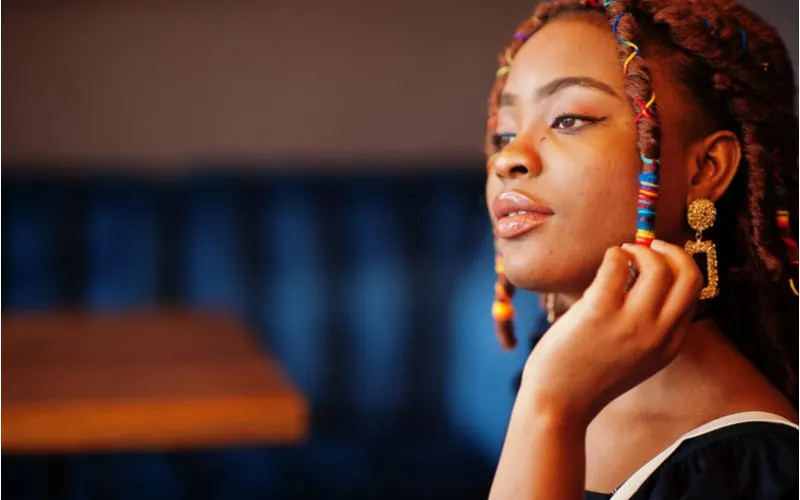Jump to:
If you’re wondering how to free form dreads, you’re in the right place. This is a very organic way to wear natural hair, and you’ll look just like Marley rocking the style! Read on to learn all you need to know.
How to Free Form Dreads in 5 Easy Steps
Freeform dreads are great because once the conditions are right, they’ll practically form themselves. All you need to do is get your hair ready to go, and then groom your new locs. In a nutshell, the process entails the following:
- Learn about freeform dreads
- Wash and dry your hair; don’t use conditioner
- Get your locs started
- Maintain your freeform dreads
- Style your freeform dreads, if desired
Of course, this is just an overview. Be sure to read until the end to learn about each of these steps in detail and see things to consider before rocking dreads.
Read Next: What Are Dreadlocks?
Step 1: Understand Freeform Dreads

ShotPrime Studio/Shutterstock
When it comes to hairstyles, freeform dreads are about as natural as you can get. After the locs have formed (more on that later), there’s virtually no maintenance required. You may choose to separate your locs if they’re thicker than you prefer, but you can also just let them loc naturally. You can also style your locs in buns, ponytails, or other up-dos if you prefer.
One of the reasons so many people choose freeform dreads is that they’re so easy to care for. Manicured dreadlocks require lengthy salon appointments to keep them tight and trim, and they also require a home hair care regimen. With freeform dreads, all you need to do is wash them.
You should, however, be prepared that it can take up to two full years for your hair to completely loc. Some people are lucky enough to achieve tight locs much sooner than that, but you should probably be prepared for a somewhat awkward growing period. This could be a great time to start a hat or scarf collection!
Freeform dreads are a journey into self-acceptance. They’re a way for you to fully embrace the beauty and uniqueness of your natural hair. Among dreadlock connoisseurs, they’re appreciated for their authenticity.
Step 2: Wash and Dry Your Hair

Fizkes/Shutterstock
We’re going to want to start with clean hair, so wash with a good-quality nourishing shampoo that doesn’t leave behind any residue. The easiest way to tell if a shampoo is residue-free is to wash your hands with it (as if it was liquid hand soap).
If your skin feels oily, greasy, or soft, or if there’s a fragrance clinging to your skin after you rinse the shampoo off, you’ll know that this shampoo doesn’t completely rinse clean. It’s not one you’ll want to use now.
Don’t use a conditioner; conditioners are designed to keep hair from tangling, and this is the exact opposite of what we’re looking to do. If your hair needs it, moisturizing oil is fine! Next, you’ll thoroughly dry your hair. Start by wrapping it in a microfiber towel to absorb extra moisture without damaging your hair.
Then, you can dry with a blow dryer on a cool setting if you want. If you do use a blow dryer, you should be constantly moving it between sections of your hair so that you don’t accidentally “fry” any of the hair. Healthy hair is more likely to loc properly.
Step 3: Start Your Freeform Dreads
The whole point of freeform dreads is that they form naturally from your natural hair! So, by definition, you don’t have to do anything to get them started. If you don’t do anything to your hair, locs will eventually start to form.
Coarse, curly hair locs more quickly than straight or fine hair. Long hair takes longer to loc than short hair since the weight of the hair pulls it downward instead of letting it kink up. If you can relieve any of the tension on your scalp, this may help your locs form.
There’s generally the most friction at the back of the head, since the back of the head rubs up against vehicle seats, chair backs, pillows, and so on. This means that locs usually form at the back of the head first. Some people choose to wear tam hats, which increase friction across the entire head. This helps locs form more quickly and also more evenly.
Everybody’s hair is different, and some people will get their locs much more quickly than others. Be aware, though, that it can take up two full years before locs are fully formed. This feels like an eternity, but remember that once done, you won’t have to do anything else to your hair for a long time. Freeform dreads are an investment of time, but there’s a payoff at the end!
Step 3(b): Start With Twists
If you just read that it can take two years to complete your locs and you’re feeling dismayed, we have a cheat for you. Not everyone is willing to wait months or years for their freeform dreads to complete, and there’s a way to speed up the process without sacrificing too much of the character of this style.
While much of the appeal of freeform dreads is their authentic, natural look, you can still get much of the same feel if you start with semi-random single braids or twists. Don’t use any styling products and don’t part your hair – just install small braids to encourage your hair to loc as it grows out and around.
These won’t be completely freeform dreads since you started the process, but you’ll get your locs much more quickly, and they’ll also be easier to manage during the locking process. You’ll also have more control over the size and direction of your dreads.
Step 4: Encourage and Maintain Your Dreads

Rock and Wasp/Shutterstock
Again, since you want your freeform dreads to loc up naturally, there’s not a whole lot that you should be doing here. If some of your locs are trying to grow together and you don’t want them to, you can separate them slowly and gently. Start from the bottom and move toward the scalp.
Despite the (inaccurate!) perception of dreads as “dirty,” you can and should wash your locs regularly. The frequency depends on your hair and scalp and external factors such as how much you sweat. Most people find that washing once or twice a week works best.
You can use a pre-cleanser if you prefer. Otherwise, just use your favorite residue-free shampoo. Focus on cleaning the scalp, and make sure you rinse all the shampoo out thoroughly. Don’t use any sort of conditioner or detangling product; these will weaken your locs.
It’s essential to dry your locs completely; otherwise, they’ll get a bit musty, and that’s not what anyone wants. Blot with a microfiber towel and then either air-dry or use a hood dryer. If you want, you can smooth a frizz control product or a moisturizer over your locs.
Step 5: Style Your Locs

AS photostudio/Shutterstock
Most of the time, your freeform dreads will make their own style statement! However, it’s always fun to switch things up, and you may want to try a more tailored look from time to time. You can use hairpins to create a layered look, or you can also use hairpins to pull a few locs back.
It’s fine to style your locs in whatever look you like but be sure not to create tension at the roots or hairline. This can weaken your hair, thin out the locs at the root, and prevent healthy new growth. Take out the hairpins when you get home to preserve your freeform dreads.
Things to Consider
Freeform dreads are a very low maintenance way to wear your natural hair. However, even though it’s a natural and low-maintenance style, there are a few things that you’ll want to keep in mind to keep them healthy and strong.
- Start with clean, dry hair. Don’t use conditioner before starting your locs.
- You can use a tam hat to encourage locs to form evenly.
- The locking process should start within a week or so, but it can take up to two years for the locs to fully form.
- You can use simple braids or twists to get a head start on this process without seriously compromising the natural look.
- Wash your freeform dreads regularly, focusing on the scalp and never using conditioner. Make sure to dry the locs thoroughly.
- Style your locs if you like, but make sure that you don’t pull on the roots or the ends.
So, How Do You Freeform Dreads?
There you have it — how to freeform dreads. Despite looking a little intimidating, freeform dreads are a very natural and low-maintenance hairstyle. Start with clean hair, don’t part or comb it, and you’ll eventually have a magnificent head of freeform dreads!
